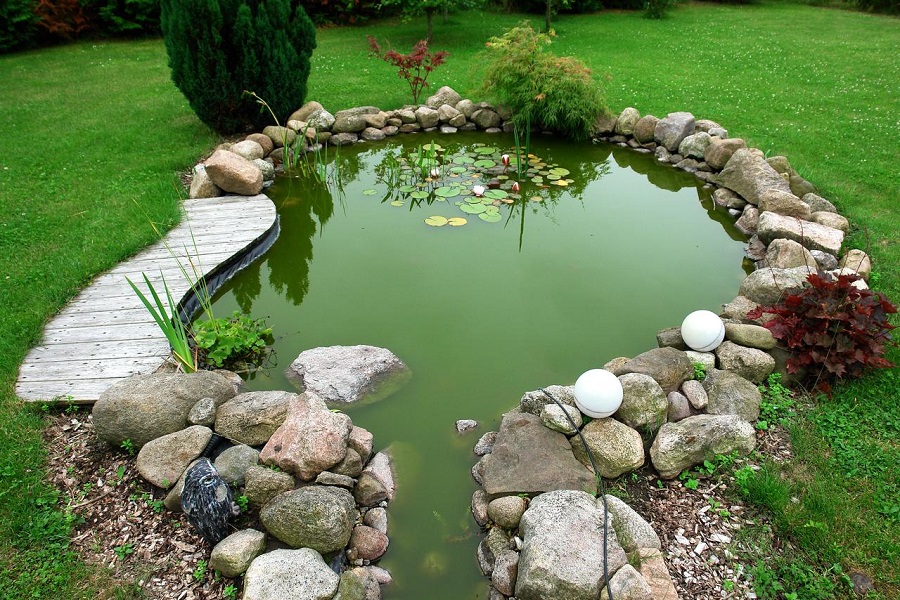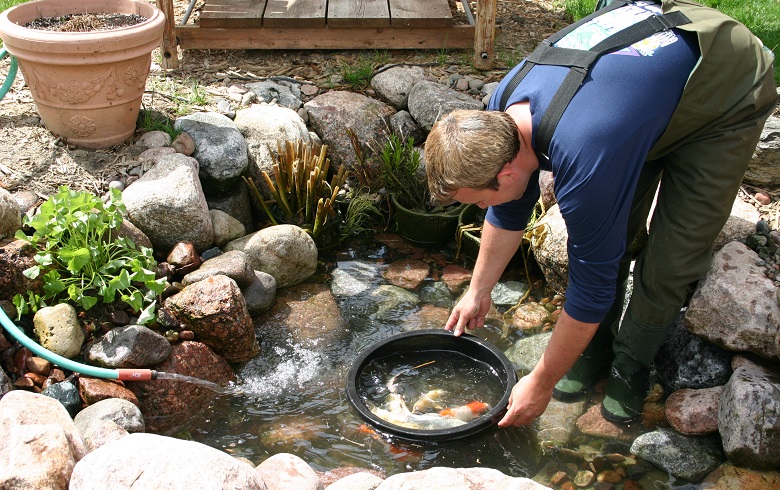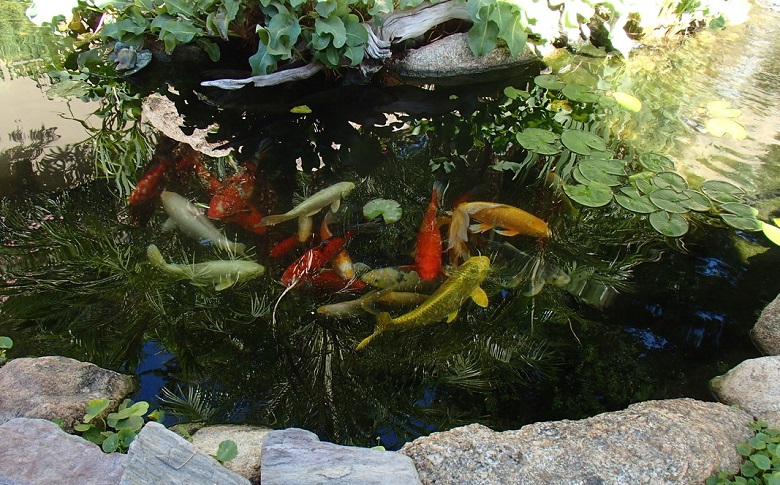If you are a water gardener, then you already know that clean water in your pond is crucial to the habitat.
However, keeping pond water clean at all times can prove to be challenging if you don’t know how to go about doing.
In some cases, water may be clear, but your fish could be acting strangely, and this signals that something is amiss in the pond. The good news is that with a little education and experience, you will be better equipped to resolve your pond water issues.
There are many ways to keep your pond water clean, which involves using chemicals or going all-natural. So let’s take a closer look at these methods.
Contents
Do I Need to Store the Fish Somewhere While Cleaning?
As we mentioned earlier, there are many ways to go about cleaning a pond; however, one of the most effective methods is to completely drain the water. Trimming plants, changing filters, and pressure washing the pond liner are other methods of effectively cleaning out the pond.
However, the challenge is that these tasks can stress and also agitate your fish. And when your fish are uncomfortable or scared, they may hide in places and may become stuck or injured. In fact, there have been cases where fish were so terrified that they’ve even tried to jump out of the pond, which will ultimately injure them if it is not fatal.
When fish become stressed, they are also more vulnerable to illness, and extreme stress can cause death. So when you plan on cleaning your pond, it’s best to keep your fish in a safe location where they will be at ease until they are moved back into their freshly cleaned home.
Temporary housing for your fish should be an appropriately sized container that is suitable to hold water while you’re cleaning the pond. The container should preferably be at least 12 inches deep and includes wading tubs, kiddie pools, a large aquarium, tanks or plastic tubs, and other watertight containers.
Start by rinsing out the containers and ensuring there are no contaminants or foreign objects inside, which could harm your fish. Thereafter, the container should be placed in full or partial shade, and under no circumstances should you put the container in direct sunlight. It may get too warm for the fish as the water will heat up small containers.
The containers should be filled with water from your pond, which will be most comfortable and less stressful for your fish. You should also have a mesh screen at the top of the container to prevent fish from jumping out and keep them safe. If you don’t already have a mesh or natural cover for the container, try using a window screen as a makeshift cover.
In order to minimize the time your fish spends out of their natural environment, make sure that you have all of the supplies and tools on hand before taking your fish out of their pond. Ultimately, the goal is to have your fish in the temporary home for as little time as possible so as to minimize stress on them.
How Do I Clean a Fish pond?
Equipment Needed:
- 5 Gallon bucket
- Pond cleaning net
- Rubber gloves
- Large container (if removing fish)
Step 1:
Use the pond cleaning net to skim the top of the water and ensure that you remove debris and floating leaves on top of the water.
Step 2:
Remove the decorations, plants, and the pump. Be sure to unplug the pump before removing it as well as any decorations and plants as it will make it much easier to clean the bottom and sides of the pond.
This would also be an ideal time to get rid of any dead leaves from the plants. Your pond will stay cleaner for longer if you keep the pond plants well-maintained. So feel free to remove any dead leaves, roots, and stems. Rinsing off the plants is a good idea to get rid of and debris and muck that comes out of the pond with the plants.
Step 3:
In this step you need to remove the fish; that’s if you plan on draining the pond to clean it thoroughly. If the water is extremely dirty and has a bad odor, or there’s muck at the bottom, then it is recommended that you remove the fish before you start cleaning out the pond. Alternatively, you can leave the fish in the pond and skip this step.
If you’re planning on removing the fish, then the container should be deep enough to hold them with water from the pond. You should only use the pond water to fill the container and not water from a hose or tap as it will kill the fish. Thereafter transfer the fish into the container and covered it with a net or mesh so that they do not jump out. Keep your fish out of the sun as well until you’re done cleaning the pond.
Step 4:
Most people prefer to use their pond net to clean the bottom of the pond. Or you can simply drudge the bottom of the pond and scoop out all of the debris and mock.
Be sure to get into the corners and clean off any plant shelves as well. You can also try using a small pond vacuum or pool skimmer if you have one available.
Step 5:
One thing you don’t want to do is remove all of the algae from the sides of the pond. Pond algae are beneficial to the fish as well as the overall pond ecosystem.
However, if there’s an overgrowth of algae, then you definitely want to clean that out. A basic toilet brush works wonders when it comes to cleaning the bottom and sides of the pond, where algae tend to becomes a problem.
Step 6:
Clean the pond pump and filter. All of the debris should be removed from the pond pump and filter. So fill a 5-gallon container of water, or you can use the rainwater to rinse the pump and filter instead of water from the garden hose.
This is because chlorine is not beneficial to the good bacteria in your pond. So fill a small bucket with pond water and use it to rinse off the pump and filter, and in the event you don’t have a pump and filter, it’s a good idea to invest in one. It’s much harder to maintain a healthy and clean fish pond without these tools.
Step 7:
In this step, you need to put everything back into the pond. Since you’re done cleaning the pond, you can put that plants, decorations, pump, and fish back into their natural habitats.
In the event that you drain the pond completely to clean it, fill it up with chlorinated water, but wait at least 24 hours before placing your fish back into it. Failure to do so could lead to your fish dying.
Acclimating Pond Fish
Ideally, the acclimation process should begin within the hour of purchasing the fish. The bag should be kept out of direct sunlight during transportation, and it’s going to be more than an hour before you can start the process, brief your salesperson to prepare your fish for a longer trip.
Once you’ve reached your pond, open the bag and add some the pond water into the bag. A few cups should be ideal to start with. Thereafter float the bag for about five minutes while securing the bag to the pond’s edge. While the bag should be left open, the new fish should not be left to swim out of the bag just yet.
Step two should be repeated, and you should add more pond water into the bag until it reaches approximately 10 to 20% of the amount of water in the bag. Float the bag again for another five minutes and repeat this step for approximately 15 minutes or longer. After your fish have been acclimated for between 45 to 60 minutes, it’s time to release them into their pond.
Conclusion
Your fish pond is an amazing backyard water feature that brings a facelift to the entire outdoor space.
However, there are times when cleaning the pond can prove to be a challenge; that’s if you don’t know how to do it. The good news is that by using a few simple tools and following a few steps, cleaning your pond will be hasslefree.

Ian Sterling, founder of Fishlab.com, began his aquarium journey over 30 years ago, driven by a deep fascination for fish and their diverse personalities. His website, Fishlab.com, is dedicated to making fishkeeping accessible and enjoyable, offering beginner-friendly guidance, expert insights, and a community for aquarists to connect and share experiences.





